It’s often said that you can take every single human being on the planet, put them in Texas, and they couldn’t reach each other by throwing a baseball. For beetles calling Texas home, there’s certainly plenty of space to go around.
There are 208 species of beetle in the state of Texas, which is more than most states can boast. Of course, the state’s massive size is more than accommodating for that many species. Texas is also home to ten ecoregions, including marshes, prairies, high plains, rolling plains, trans-pecos, plateaus, savannahs, and desert-like conditions.
With that kind of environmental variety, there is an opportunity for a huge diversity of beetle species, depending on the environment each is most suited for. At 266,807 square miles, Texas is only second to Alaska in pure landmass. Beetles calling Texas home couldn’t ask for a better state to live in.
Black Beetles in Texas

There are 208 species of beetle in the state of Texas, which is more than most states can boast.
©iStock.com/mirza kadic
Not all black beetles are black beetles, but they fall under different categories. Black beetles may be the name of a group of beetles, but that doesn’t mean they’re all black. For instance, the tomentose burying beetle has bright red stripes but is still black.
In Texas, there is a fairly sizeable family of black beetles. The most notable black beetles are black blister, short-winged blister, black turpentine, and the eastern-eyed click beetles. Except for the black turpentine beetle, none of the above beetles is entirely black.
Then again, people sometimes confuse some beetles with black beetles because they have similar names, such as the various tiger beetles and ground beetles. The American oil beetle, also known as the black oil beetle, is one of the most important in Texas.
The reason they are important is because of their vulnerability and sacrificial status. Everything from the size of a squirrel to the size of a snail feeds on American oil beetles. That’s bad news for this particular black beetle and excellent news for the rest of the food chain in Texas.
Large Beetles in Texas
Texas, like most other states, has huge beetles. The largest of the beetles calling Texas home are the giant stag beetles, which grow to over four inches in length. Even though these beetles are enormous and extremely vicious-looking, their current conservation status is largely unknown.
Giant stag beetles run the gamut from pure black to a reddish, glossy brown. Their front pincers are enough to send most people running in the opposite direction. They are huge and sharp but mostly useful for grabbing smaller prey animals. The giant stag beetles in Texas are almost exclusively located in the very eastern portion of the state and nowhere else.
Texas is also home to the eastern Hercules beetle, which is a massive beetle, even by the standards of the giant stag beetle. The male can reach a jaw-dropping 7 inches in length. The Hercules beetle has far more colorful and neat tan and black combinations, which are designed for camouflage but look amazing all the same.
Large beetles and black beetles are only the tip of the iceberg in Texas. There are far more to cover, and some are very interesting.
1. Short-Winged Blister Beetle
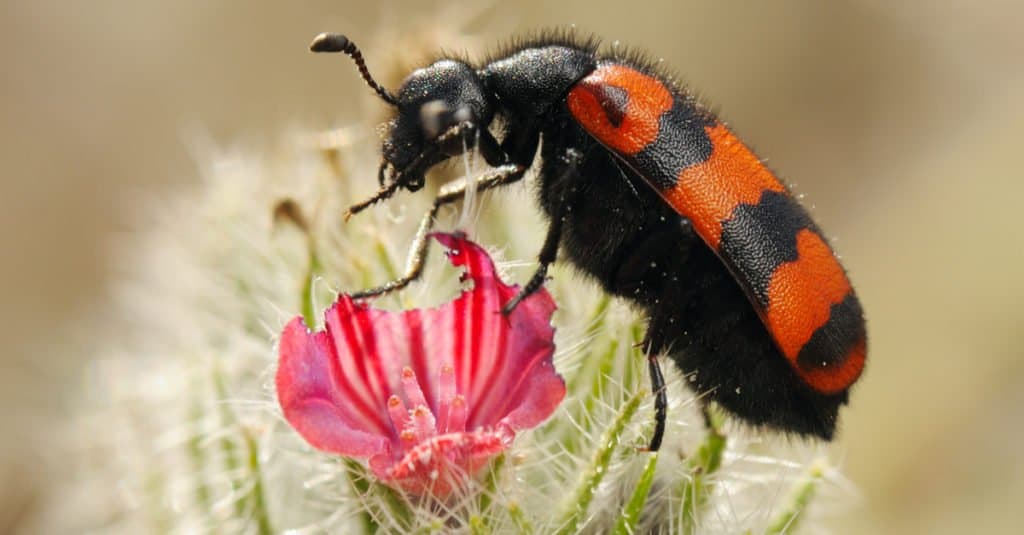
The blood of a
blister beetle
contains a corrosive substance known as cantharidin. When this stuff gets on human skin, it immediately irritates it.
©vblinov/Shutterstock.com
If you spend a lot of time on A-Z Animals, blister beetles are probably pretty familiar to you. But that doesn’t make them any less fascinating. Texas is home to the short-winged blister beetle, and like all blister beetles, it has a unique defensive mechanism.
The blood of a blister beetle contains a corrosive substance known as cantharidin. When this stuff gets on human skin, it immediately irritates it. Sometimes, it turns the spot red—just a minor irritation. Oftentimes, however, it irritates the skin enough to create a raised blister that’s painful to touch.
The short-winged blister beetle of Texas is otherwise known as the American oil beetle. It is completely black and has a sheen to it. The closest insect it resembles is a common ant, with rounded, large segments that grow smaller as you move toward the head.
2. Tortoise Beetle

The Argus
tortoise
beetle closely resembles a ladybug in terms of body size, body shape, and markings on its back.
©iStock.com/bookguy
If ever there was a bug that surely came to Earth from another planet, it’s the tortoise beetle. This bug is creepy beyond the word creep but endlessly fascinating all the same. The tortoise beetle belongs to the family of leaf beetles, and it kind of looks like a leaf, with hundreds of hairy protrusions along its edges.
Tortoise beetles aren’t all one color either. Some are entirely lime green, while others are a series of tans and browns sunk into a translucent outer membrane. At least, that’s what it looks like. The coolest thing about them is their color patterns.
They’re all different, with various patterns, mostly in the above-mentioned colors. Occasionally there’s a black or red in there as well. They aren’t invasive nor destructive, except for various leaves. It’s not common to find a tortoise beetle eating the leaves of your garden plants. So, no need to worry.
3. Green June Beetle
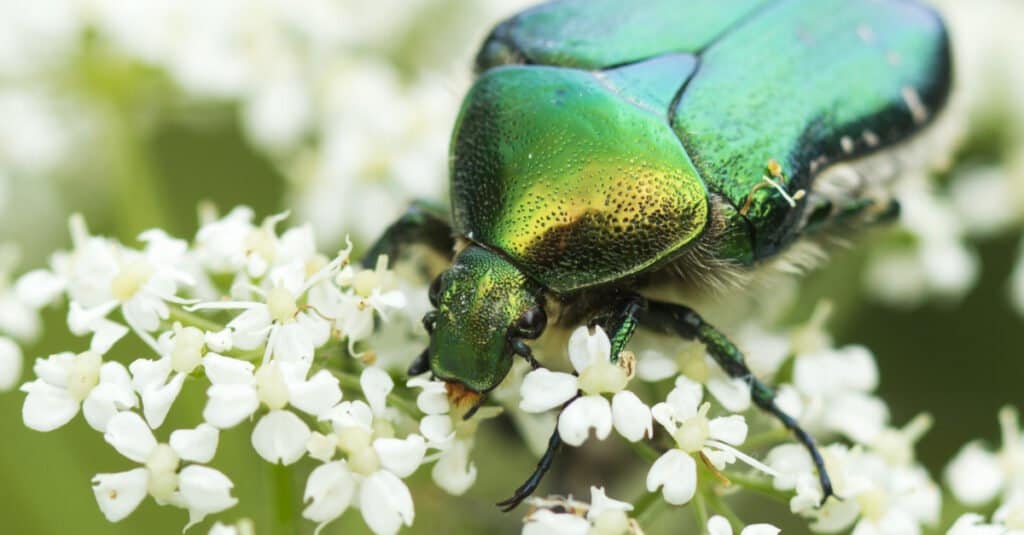
A Green June beetle eating flowers. These types of beetles are turf pests that eat a variety of vegetation.
©Galina Savina/Shutterstock.com
There is beauty in nature, and the green June beetle contributes. If you like metallic aesthetics in nature, you’ll love the green June beetle. Out of all the beetles calling Texas home, these June beetles are the most reflective and eye-catching.
Their body contours are also unique, with the line separating the wings feeding into the thorax/abdomen segment and forming an upside-down triangle. The green June beetle is the perfect example of symmetry in nature.
The ancient Egyptians were fantastic at creating symmetrical stone faces, but not even they could match the perfect lines and symmetry of the green June beetle.
4. Giant Stag Beetle
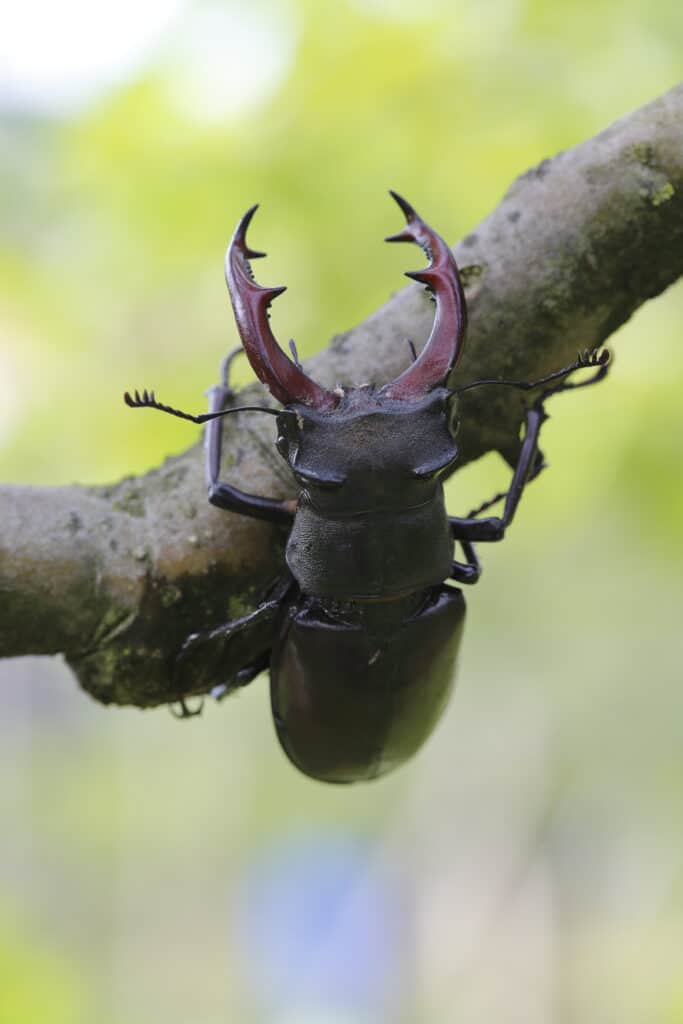
Giant Stag Beetles (
Lucanus elaphus) depend on dead or dying wood.
©iStock.com/Lukasok
We covered the giant stag beetle in the “large beetles” section, but throwing it in with the most interesting beetles calling Texas home is simply a must. The giant stag beetle is one of the most unbelievable beetles in all of the known world.
Its size is staggering. At over 4 inches in length, the giant stag beetle has no predators save for a very few superior-eyed birds of prey that lack any fear. Their pincers are enormous but, fortunately, lack any real force. Their chewing parts are immensely powerful but too small to get ahold of your skin in all but the most extraordinary of circumstances.
As intimidating as they look, giant stag beetles are surprisingly docile and are likely to doze in the palm of your hand rather than get up to no good. They mostly feed on decaying wood and use their massive mandibles to wrestle other stag beetles when courting a potential female.
5. Rainbow Scarab

The rainbow scarab sports a metallic, reflective surface that takes on a rainbow sheen in the sunlight.
©catocala7/Shutterstock.com
Nothing beats the green June bug, in terms of metallic aesthetics, except for the rainbow scarab. Where body shape is concerned, both beetles look remarkably similar. The rainbow scarab sports a metallic, reflective surface that takes on a rainbow sheen in the sunlight.
The most interesting are the males, but only because they have a unique horn that curls up and back, along with a bright, metallic yellow head. The male and the female are unique exhibits if you ever catch one out and about, and both are generally docile and harmless.
Another interesting capability of both male and female rainbow scarabs is their retractable antennae. It’s much like those old-school, brick-shaped cell phones where the antenna pulls out of the set for a better signal. Both are rare beauties and a wonder to look at if you ever come across one in Texas.
6. Ironclad Beetle

An ironclad beetle’s hard shell helps it retain water.
©GypsyPictureShow/Shutterstock.com
The ironclad beetle makes the list of the most interesting beetles calling Texas home because of its exciting color aesthetics. They are otherwise similar to other beetles, but if you threw a bunch of beetles in a pile with this one, you could quickly pick it out.
The ironclad beetle features color aesthetics reminiscent of Dalmatian dogs. The only exception is that the black tends to run vertically in a line down its center. It’s a unique pattern and immediately draws the eye. Ironclad beetles get their name from their incredibly thick shell, which is used to hold onto extra water throughout the day.
They feed mostly on lichen and moss when they can find it and, since they live in a drier climate, are always absorbing what water they can find. They are an important lesson to kids to hold onto the things they need in case they have to go a long time without.
7. Emerald Ash Borer
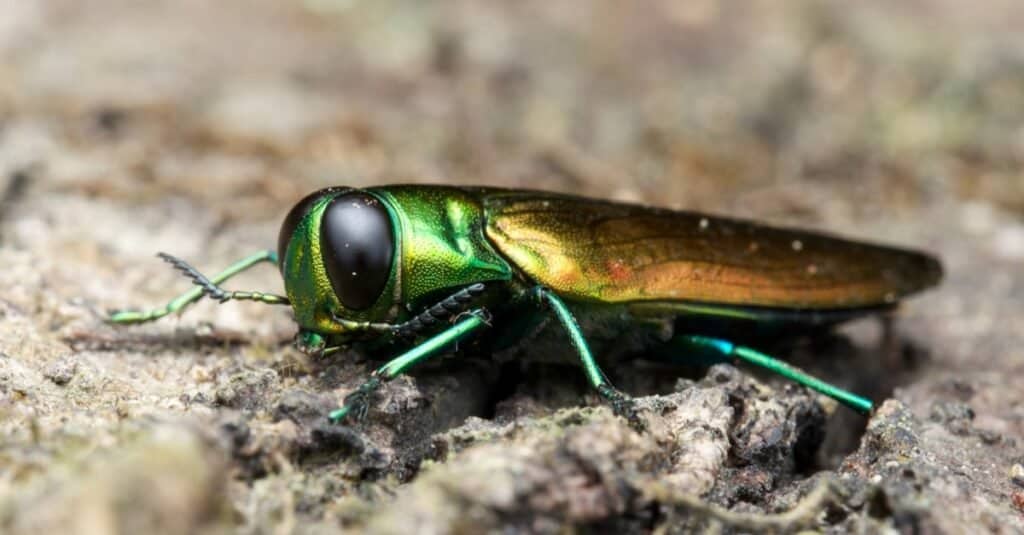
The Emerald Ash Borer, a type of beetle, kills ash trees by destroying the water and nutrient-conducting tissues under the tree’s bark.
©Herman Wong HM/Shutterstock.com
With a similar green and metallic sheen to that of the green June bug, the emerald ash borer combines the huge-eyed fly with the lengthy grasshopper. They even have the eyes of a grasshopper—massive and directly forward on their face.
Below their large, black eyes, their antennae extend from their face. It seems as if they come directly from the nostrils, though emerald ash borers lack nostrils in that sense. They’re extraordinarily beautiful beetles, with their metallic sheen that’s mostly green and turns into a rainbow when the sun strikes it.
Unfortunately, the emerald ash borer is an invasive species that go after trees in Texas. These trees are mostly in protected forests. They don’t stop there, either. Emerald ash borers are more than happy to bore into the wood around your home, shed, garages, and shops.
8. Eastern Hercules Beetle
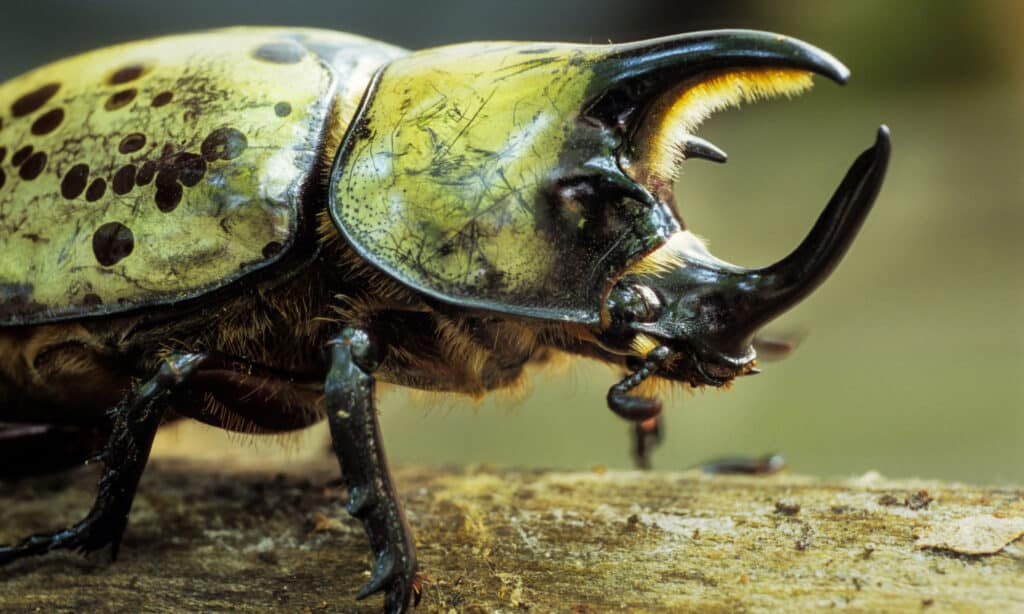
The eastern Hercules beetle grub is so large it rivals the giant stag beetle’s length long before it transforms into an adult.
©Gerry Bishop/Shutterstock.com
Another beetle we previously mentioned in the “large” beetles category, the eastern Hercules beetle, is just too neat to leave out. These large beetles are typically tan and black, with the black making up a tiny percentage of the overall creamy tan color of the beetle.
The eastern Hercules beetle grub is so large it rivals the giant stag beetle’s length long before it transforms into an adult. With a male that can reach 7″ and a female not far behind, the eastern Hercules is the largest beetle in the world; many live in Texas.
Thankfully, for humanity, they only eat dead and dying tree bark, tree sap, and rotten fruit. They aren’t much interested in anything else.
9. Case-Bearing Leaf Beetle
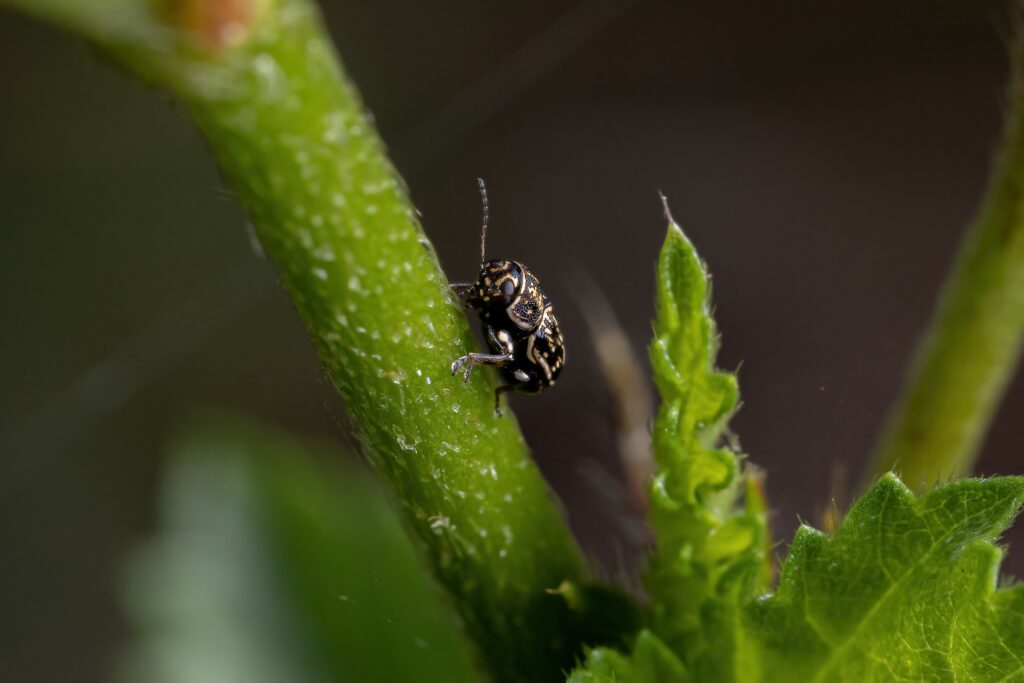
The case-bearing leaf beetle carries around its body casing, covering the entire abdomen and most of the thorax like a shield.
©Vinicius R. Souza/Shutterstock.com
What makes this beetle so interesting is its instinctive desire to be a turtle or a snail. The case-bearing leaf beetle carries around its body casing, covering the entire abdomen and most of the thorax like a shield.
These beetles are either matte black or gloss black and feature red or orange stripes. The casing that it carries around for most of its life is a defensive mechanism. It protects them from predators and even from the weather.
Like a turtle, they can conceal themselves in it when danger is near. They can sleep in it as well. The case is usually very rough in texture, with a series of raised bumps concealing the vulnerable bug within.
10. Eastern-Eyed Click Beetle

The eastern-eyed click beetle is unique looking.
©Elliotte Rusty Harold/Shutterstock.com
We saved the best for last because this is truly one of the most incredible and haunting-looking beetles on the list. That certainly qualifies it as interesting. The name implies something about the beetle’s eyes. The fact is, it’s not a direct reference to its eyes at all.
The eastern-eyed click beetle features two massive black spots on its thorax. They’re large enough and disconcerting enough to trigger someone with trypanophobia. Even better, the large, black dots are outlined in a thick, shining white line.
The outline makes it look like the dots are carved into the click beetle’s thorax. The rest of its body is a mottled gray, white, and black. In terms of standing out, it’s hard to think of another beetle that looks as fascinating as the eastern-eyed click beetle.
Final Thoughts
Texas is the second largest state in the US, and its positively packed with all manner of creatures, including beetles. The above list includes some of the most interesting beetles calling Texas home. The most profound fact of all is the number of ecoregions in Texas.
This opens Texas up to a wide variety of diverse beetles and bugs of every strip. That includes animals as well. While most beetles are fairly innocuous and keep to themselves, some of the ones on this list are capable of devastating damage.
Fortunately, Texas forest management and farmers are well aware of and prepared for such things. The best thing about Texas is the wonder and beauty of the country, as well as the variety of beetles it has to offer even the most casual observer.
The photo featured at the top of this post is © Elliotte Rusty Harold/Shutterstock.com
Thank you for reading! Have some feedback for us? Contact the AZ Animals editorial team.






